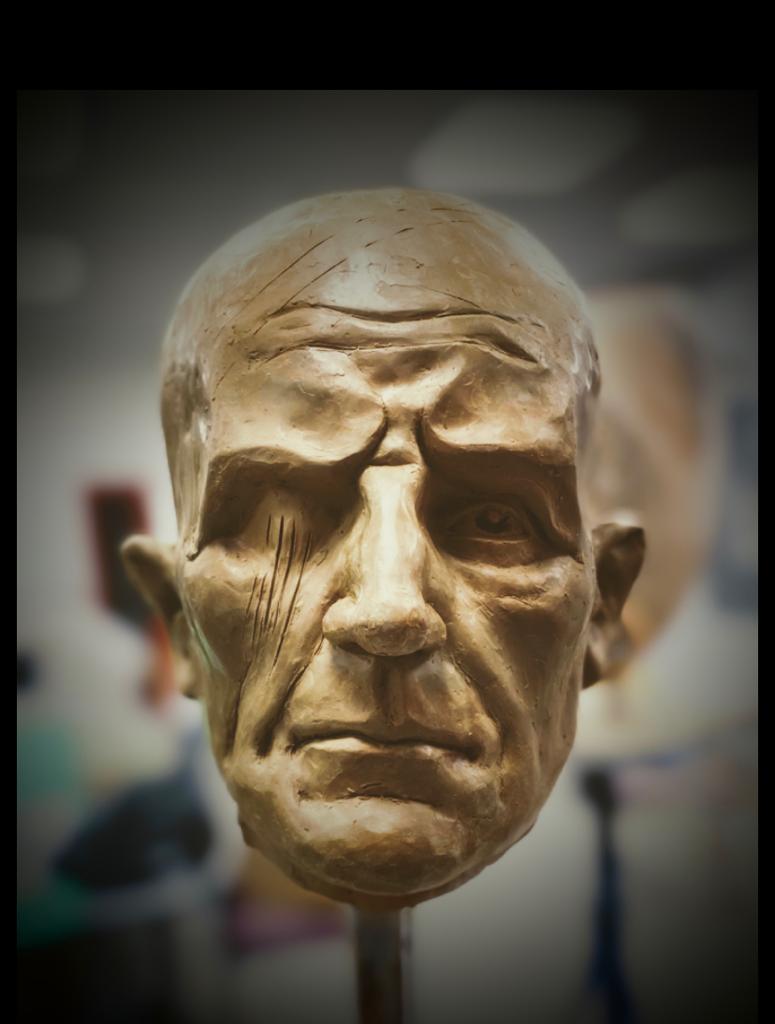
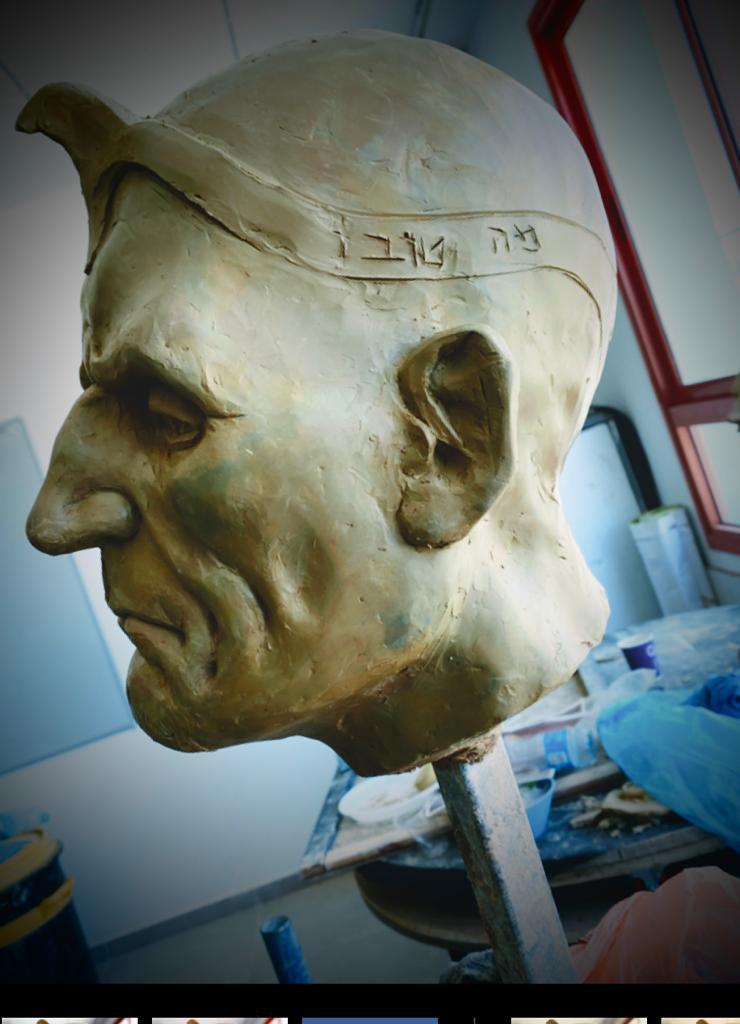
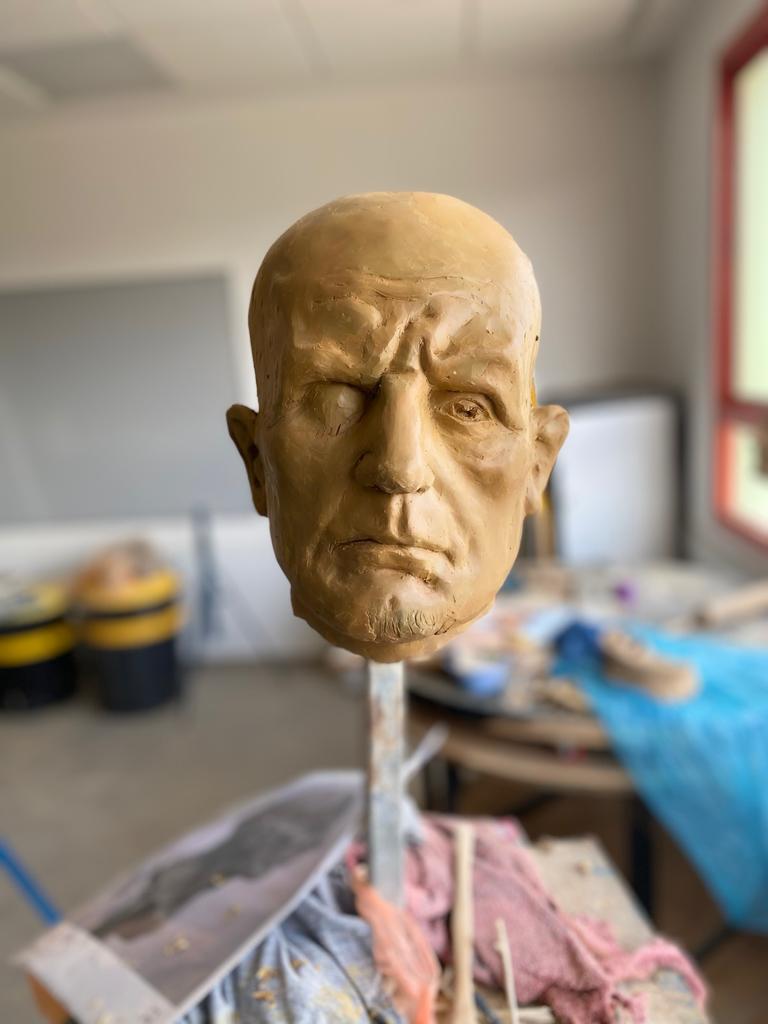
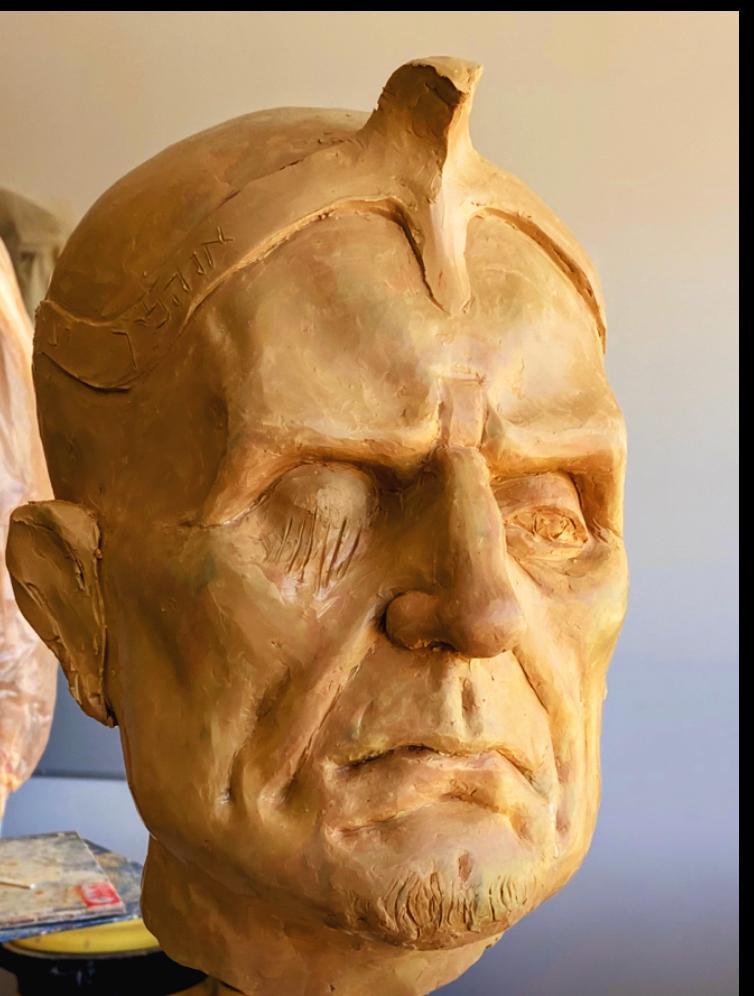
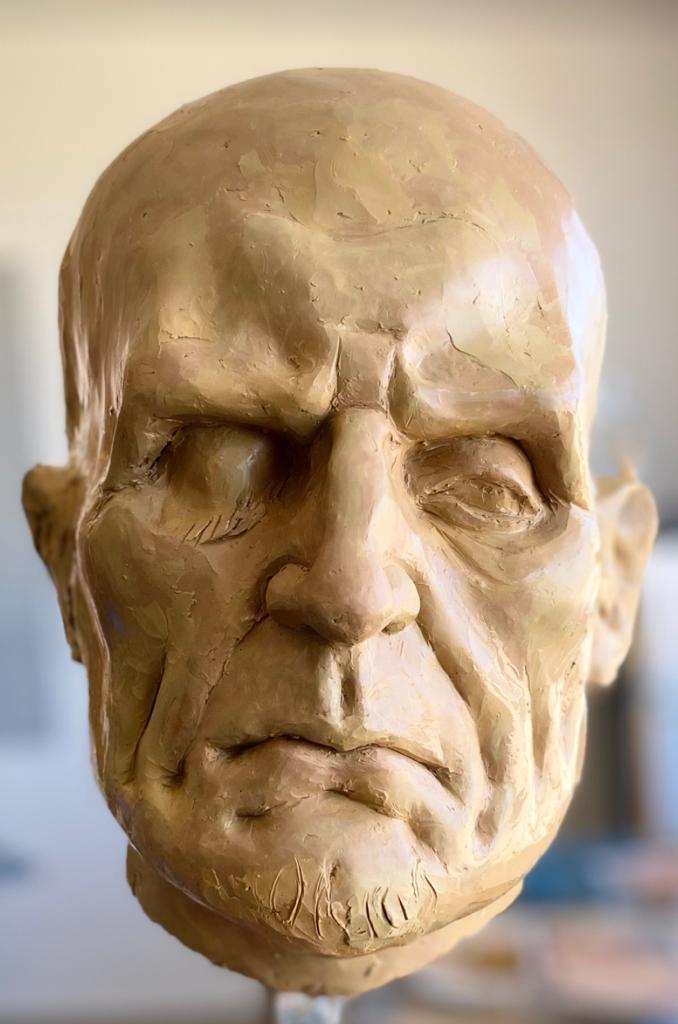
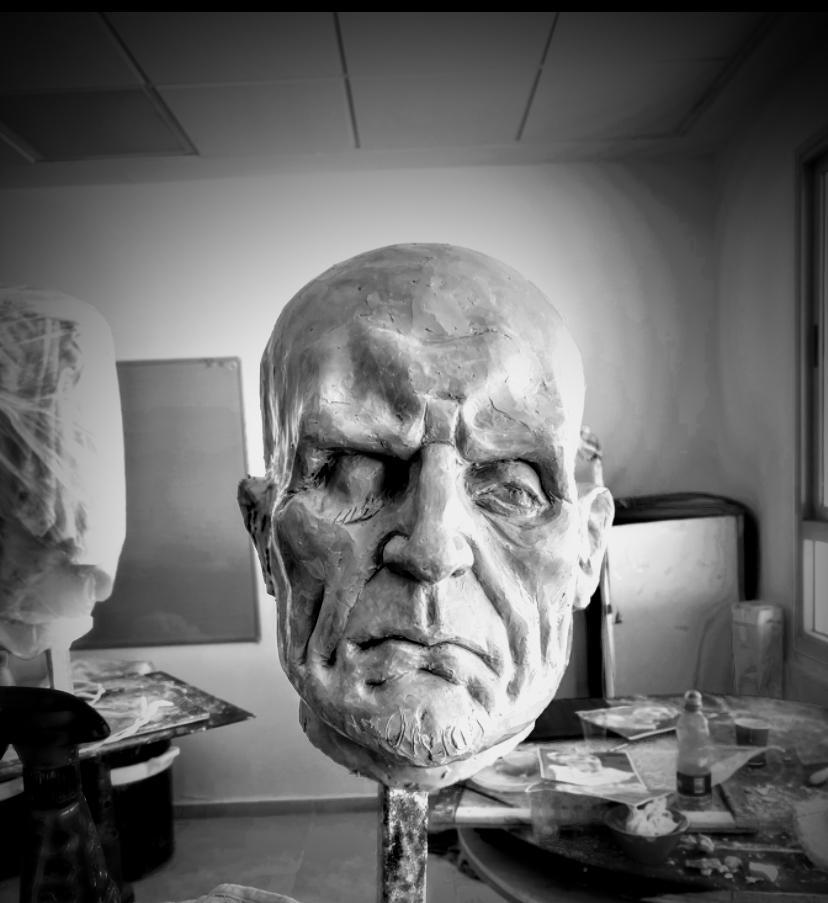
Video of the Rabbi and Artist in conversation about the Parsha:
https://www.theameninstitute.org/weekly-parasha-inspiration/balak
For more about Artist Tsuriel Sdomi: https://www.theameninstitute.org/tzuriel-sdomi
For more about Rabbi Ronnie Cahana: https://www.theameninstitute.org/ronnie-cahana
Piece Description:
Tsuriel Sdomi, “Bilaam’s Indefatigable Obsession"
"Bilaam’s Indefatigable Obsession" depicts a bust of the prophet, tormented and destroyed by his incessant need to act upon his anti-semitism. In the torah portion all of the forces of nature do what they can to stop him, but his hatred is too great and so he eats himself alive in the torment and chaos of his vociferous loathing of the Jewish people.
Discussion Questions:
1. Tsuriel Sdomi chooses to only depict the bust of Bilam. How would the image be different if we saw the rest of his body?
2. By showing Bilam in three-dimensions does his evil appear more real? More gruesome? How does the fact that it could be seen from different angles and in different lighting affect your experience of this image?
3. Although most art shows the final form of the image, throughout the sculpting process, Tsuriel Sdomi’s different iterations and choices often took on different characters completely? Compare two different versions of the image, what are the differences you see in their composition, and in the subtleties of Bilam’s expression? Do different versions drastically change his character? What message can the dynamic nature of the sculpting process have on the viewing experience?
4. Tsuriel Sdomi chose to focus on Bilam instead of Balak? Which of the two characters in your opinion is worse? Why?
Rabbi Ronnie Cahana:
“In every generation they will come to destroy us.” (Haggadah)
“And I will make you into a great nation, and I will bless you, and I will aggrandize your name, and you shall be a blessing. And I will bless those who bless you, and the one who curses you I will curse, and all the families of the earth shall be blessed in you.”
(Genesis 12:2-3 … as the background trope to surrender the whole parsha)
Tzuriel Sdomi decided that he was captivated by Bilam, even though this parsha is named after Balak. And so he sculpted the metzora of Bilam’s face as his art project. One eyed as the evil eye, advertising the drive to curse when nobody can curse in a holy way.
The sculptor blew me to smithereens with one two-word insight: Bilam reconstructs to (בלי עם). I will never be the same again. B’li am, without a nation. He was a prophet without a nation, with no value of allegiance to steady him. A lone-wolf prophet without a pack … and more importantly, without a pact. No community. No covenant.
Bamidbar 22:3 — When confronted with the Israelites, Balak the king of Moab regresses from fear to disgust to hate. This is the eternal anti-Semitic wrangle of history, beginning with Pharaoh in Shemot.
We didn’t do nothin’ to Moab — we didn't want a single shoelace out of them — “just please let us go to our destination” — and the king said “no.” What troubled him so?
Bilaam was an advisor to Pharaoh, and when Pharaoh said “what shall we do with these people?” (meaning the Israelites) Bilam said to destroy them. He was a prophet equal to Moses in insight and effect — why? If there were no prophet for the goyim, then the goyim would say to the Jews: “of course you had all the power, no one is equal to Moses who knows G-d.” So therefore G-d allows for an equal and opposite mirrored relation to represent for the whole world, to avoid the whiff of a power imbalance, and they too could have raised to a holy relationship.
Bamidbar 22:18 — Bilam is hinting to the Moabites what his price is going to have to be — silver and gold — and this is offset by a reference to the Book of Genesis where G-d says to Abraham, whoever blesses you will be blessed and whoever curses you will be cursed. This, the template to the world’s relationship with the Jews — the eternal backdrop — I recited this line to the pope when we met with my mother’s Holocaust art piece showcased in the Vatican.
Bamidbar 22:27 – Three beatings is significant ... why? The number features recurring in this Parsha. Three beatings, three blessings, three views of Israel. Once is an act an occurrence, twice? A possible but three times?- deliberate, on purpose.
This may be the quintessential parsha in all of Tanakh because Israel didn’t know that Bilam was blessing them or that Balak was cursing them. We really don’t know what the goyim think of us. We only find out when we read Torah later on. At the time we had no idea that we were subject to review from afar. The same remains today: we really don’t know what our relationship is with the rest of the world. We teach our children in the Haggadah that our point of origin was in slavery, but how can we be proud of that history? In the juxtaposition of what else we emphasize: our other point of origin is Mount Sinai. We know what G-d thinks of the Israelites, but our fellow nations’ feelings are opaque. We can’t fully explain the irrationality of anti-Semitism.
Bamidbar 22:38 — Only two animals speak in the Torah. Bilam’s donkey tries to bring her master closer to an awareness of G-d while the other (the snake) tries to separate Eve from G-d. It’s amazing that a great prophet couldn’t see what the donkey could see before them, and he punishes the donkey for her evident disloyalty … but the angel then says to Bilam, you betrayed your loyalty to your donkey.
Bamidbar 23:14 — In essence Bilaam says “let me die the death of the righteous,” and instead he dies in the disdain of the wicked, by sword in the fields of Moab. He embodied our defining characteristic, the way we define ourselves as a “nation apart” that dwells alone … except he dwelled personally alone without a people. Judaism teaches us separation in the word kadosh. To have kedusha means to have our own rules, mitzvot, set apart in order to be holy.
The story is about blessing instead of cursing. It is probably the most difficult of all undertakings to be a person that is capable of cursing … only G-d can give righteousness to the cursed. Even Moses found out in the parsha before Balak: when he cursed Israel, instead he cursed himself. Whoever tries to curse Israel curses his own journey, and when he abased a parched Israel by calling them morim (rebels) and had the chutzpah to say to them: shall we bring forth the water for you? Equating himself and Miriam with the power of G-d. Again he cursed himself and for that he was forbidden entryway to the Promised Land. And he expired in the absurdity of the desert unfulfilled of entry into Eretz Israel.
What was Balak’s plot? Is he interested in undermining the nation of Israel? What should Bilam have told him he should have done, were Bilaam a righteous prophet? Bilaam should have said “Stop. What you need is only what G-d intends. Ask that you be blessed rather than obsess with cursing Israel.” The famous blessing that Bilaam gave to Israel is what Jews say when they enter a place of Jewish prayer. Hasidim used to walk into a synagogue touching the walls, touching the parameters of the holy space and reciting “Ma tovu ohalecha Yaakov, mishkanotecha Yisrael” … the place of the indwelling of G-d.
What do you say to the anti-Semite who says “Go ahead and disperse among all the nations — and you will disappear into obscurity”? Anti-semitism is irrational. It never bases itself in the advancement of the world. Reshuffling “korach” gets you “rachok” — distance — when they saw each other as distant, they saw the other as small, similar to Joseph’s brothers to him. When you approach with courage, you see the future of your own godliness reflected in the other’s power. And when you come close, you acknowledge the power of good in the other, to acknowledge your contribution as you acknowledge mine.
Below is a poem, also by Rabbi Ronnie Cahana, entitled, "Bolluxed or BeCalm"





